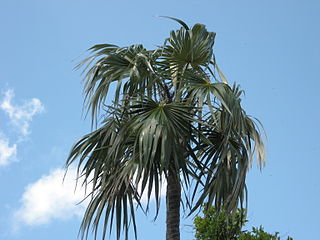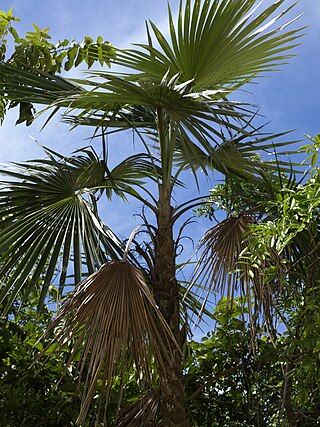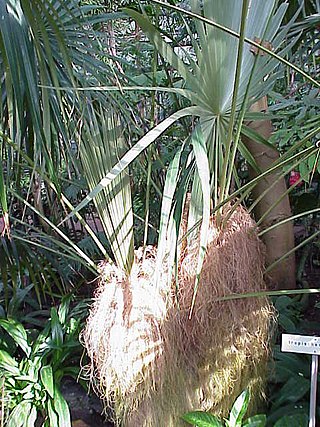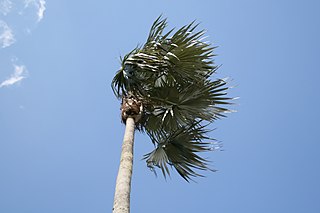
Coccothrinax is a genus of palms in the family Arecaceae. There are more than 50 species described in the genus, plus many synonyms and subspecies. A new species was described as recently as 2017. Many Coccothrinax produce thatch. In Spanish-speaking countries, guano is a common name applied to Coccothrinax palms. The species are native throughout the Caribbean, the Bahamas, extreme southern Florida and southeastern Mexico, but most of the species are known only from Cuba.

Coccothrinax argentata, commonly called the Florida silver palm, is a species of palm tree. It is native to south Florida, southeast Mexico, Colombia and to the West Indies, where it is found in the Bahamas, the southwest Caribbean and the Turks and Caicos Islands. Its natural habitat is rocky, calcareous soil in coastal scrubland and hammock communities.

Coccothrinax argentea is a palm which is endemic to Hispaniola.

Coccothrinax readii, the Mexican silver palm, is a palm which is native to southeastern Mexico and northeastern Belize.

Zombia antillarum, commonly known as the zombie palm, is a species of palm tree and the only member of the genus Zombia. It is endemic to the island of Hispaniola in the Greater Antilles. Usually found in dry, hilly areas of northern and southern Haiti and the northwest of the Dominican Republic, Z. antillarum is a relatively short fan palm with clustered stems and a very distinctive appearance caused by its persistent spiny leaf sheaths. Threatened by habitat destruction in Haiti, Z. antillarum is a popular ornamental species due to its distinctive appearance, low maintenance requirements and salt tolerance.

Coccothrinax crinita is a palm which is endemic to Cuba. Like other members of the genus Coccothrinax, C. barbadensis is a fan palm.

Coccothrinax ekmanii, also known in Haitian Creole as gwenn or in Dominican Spanish as palma de guano, is an endangered species of palm which is endemic to the island of Hispaniola.
Coccothrinax fragrans is a palm which is native to eastern Cuba and Hispaniola.
Coccothrinax hioramii is a palm which is endemic to eastern Cuba, in open sandy coastal areas. Like other members of the genus, C. hioramii is a fan palm. Trees are single-stemmed, between 6 and 12 metres tall with stems 7 to 15 centimetres in diameter. The fruit is black, 0.9–1.1 cm in diameter.
Coccothrinax inaguensis, the thatch palm or Inagua silver palm, is a palm which is endemic to the Bahamas and the Turks and Caicos Islands.
Coccothrinax litoralis, the Cuban silver palm, is a palm which is endemic to Cuba.
Coccothrinax pauciramosa, the yuraguana or yuraguana vestida, is a palm which is endemic to Cuba. Like other members of the genus, C. pauciramosa is a fan palm. Trees are single-stemmed, between 2 and 5 metres tall with stems 4 to 8 centimetres in diameter. The fruit is purple-black, 0.7–1.2 cm in diameter.

Coccothrinax proctorii, the Cayman thatch palm or Proctor's silver palm, is a palm which is endemic to the Cayman Islands.

Coccothrinax spissa, the guano or swollen silver thatch palm, is a palm which is endemic to the island of Hispaniola.

Leucothrinax morrisii, the Key thatch palm, is a small palm which is native to the Greater Antilles, northern Lesser Antilles, The Bahamas and Florida and the Florida Keys in the United States.

Sabal causiarum, commonly known as the Puerto Rico palmetto or Puerto Rican hat palm, is a species of palm which is native to Hispaniola, Puerto Rico, and the British Virgin Islands. As its common and scientific names suggest, its leaves are used in the manufacture of "straw" hats.
Coccothrinax jimenezii is a fan palm which is endemic to the island of Hispaniola in the Caribbean. First formally described in 2013, the species is only known from two small populations, and is considered critically endangered.
Coccothrinax spirituana is a fan palm which is palm endemic to central Cuba. Populations have been found in Sancti Spíritus and Ciego de Ávila provinces. Its leaves are ash-grey in colour on their upper and lower surfaces, a characteristic which is not found in other members of the genus. The species was described in 2017. Specimens of the palm were collected in Sancti Spíritus Province in 1975 and 1995.










